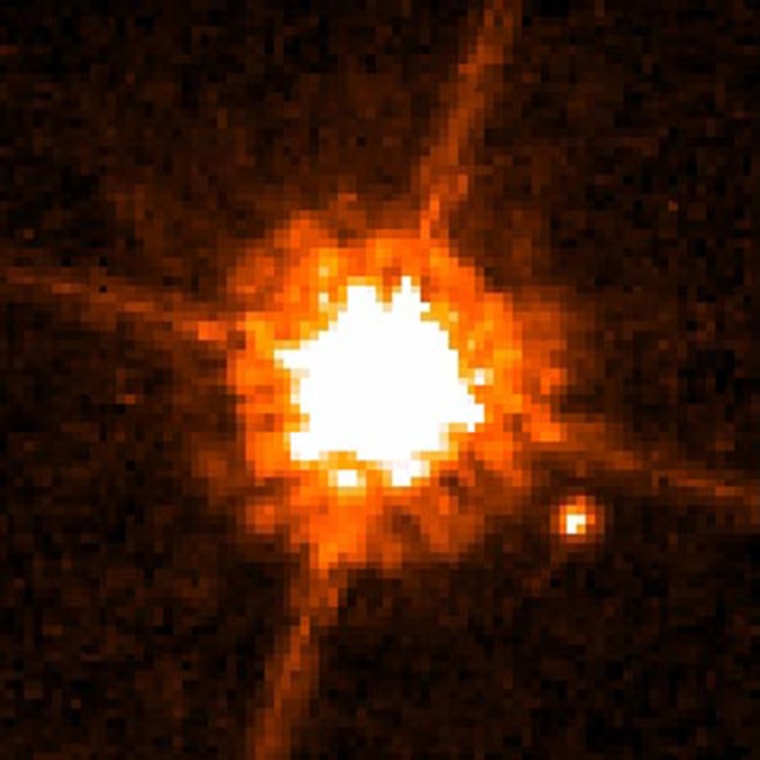The Hubble Space Telescope has spied one of the smallest objects ever detected around a normal star. The object further blurs the line between stars and planets and raises new questions about how planets should be defined outside our solar system.
Announcement of the discovery comes two weeks after the International Astronomical Union approved the first official definition of "planet" for our solar system and downgraded Pluto to dwarf planet status.
The newly spotted object is a companion to CHXR 73, a low-mass red dwarf star located 500 light-years from Earth, and is itself called CHXR 73 B.
With 12 times the mass of Jupiter, CHXR 73 B straddles the line between the largest planets and the smallest stars. The latter, called brown dwarfs or "failed stars," don't have enough mass to sustain the types of thermonuclear reactions that keep larger stars alight for billions of years.
The finding will be detailed in the Sept. 20 issue of Astrophysical Journal.
Formation history
CHXR 73 B is located about 19.5 billion miles (31.3 billion km) from its parent star, or roughly 200 times farther than Earth is from our Sun. This distance is so great that even though CHXR 73 B has about the right mass to be a planet, it likely didn't form in the same way that planets in our solar system did, scientists say.
According to standard planet formation theories, planets are created from the disks of gas and dust surrounding newborn stars. But the circumstellar disks of red dwarf stars are typically no more than 10 billion miles (16 billion km) in diameter. Furthermore, theory predicts that gas-giant planets like Jupiter should form no more than about 3 billion miles (4.8 billion km) from their stars. CHXR 73 B is located far beyond both these limits.
"This object is too far from the star to have formed within a disk of gas and dust," said Kevin Luhman of Pennsylvania State University, leader of the international team that discovered CHXR 73 B.
More likely, scientists say, CHXR 73 B formed in the manner of stars: from the gravitational collapse of large, diffuse clouds of hydrogen gas.
For this reason, Luhman believes CHXR 73 B should be regarded as a brown dwarf. Luhman believes an extrasolar object's formation history is more important than mass when determining whether it is a planet or not.
Planet or Star?
In a twist that surprised many astronomers, the definition of planet recently adopted by the IAU is not meant to apply to objects around other stars. Also, it does not take formation history into account. According to the new definition, an object is a planet if it is round, orbits a star but does not orbit a planet, and clears a path around its star.
CHXR 73 B "certainly fulfills all three of those criteria, but the IAU definition was never meant to be applied to other solar systems," Luhman told SPACE.com. "It was just for our solar system."
The new discovery is a reminder that objects in nature do not always fit into the neat categories created by scientists. Recently, astronomers spied even stranger planetary-mass objects that drift freely through space, far away from any star. Some scientists are calling the bizarre objects "planemos," but Luhman says the name is unnecessary and that the objects are really just brown dwarfs.
Next step
Scientists say the question of whether or not CHXR 73 B is a planet could be settled when the James Webb Space Telescope launches, sometime around 2013. The high resolution Webb telescope would be sharp enough to determine if, like some other brown dwarfs, CHXR 73 B has a circumstellar disk of its own.
"If it does, it's clearly an object that did not form in a disk around the star, because it wouldn't have a disk by itself then," Luhman said.
He added that if CHXR 73 B does have a disk, it would be some 5 AU in diameter, much wider than the debris rings found around gas giant planets like Saturn and Jupiter. One AU is equal to the distance between Earth and the Sun.
